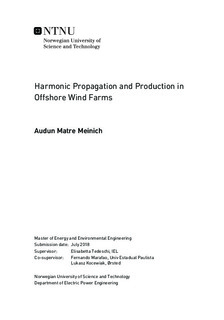| dc.description.abstract | Modern wind farms are increasing in size and complexity. As a result, increased power injected from large offshore wind farms is having a significant impact on the stability and power quality of the grid. Harmonics are a fundamental aspect to be evaluated during power quality assessment. Therefore, a thorough understanding of their behavior is needed to successfully plan an offshore wind farm.
In this master thesis, the production and propagation of harmonic components in offshore wind farms are investigated. All relevant theory required to fully understand harmonics and how they can be filtered is included. A guide for simulating the electrical components of an offshore wind farm, such as voltage source converters, cables, and transformers, is also provided.
A Simulink model of an offshore wind farm is built using data from Anholt Offshore Wind Farm in Denmark. The wind turbine in this model is simulated as a voltage source converter with an LCL-filter. A d − q reference frame is used in the control system of the converter, with a pulse width modulator to control the switches and a phase locked loop to synchronize the converter with the grid. The turbine itself is connected to a simplified offshore grid with trans- formers and subsea cables. Nine different scenarios (running the turbines at half power, grid harmonics and adding a switch-on delay among others) are simulated on this model, each de- signed to mimic factors present in real offshore wind farms. In addition, active filtering is im- plemented to limit specific harmonic frequencies.
Results from all nine scenarios show that harmonics vary greatly in the presence of each simulated factor. There are two kinds of current harmonics produced by the wind turbine; high- order switching harmonics and low-order harmonics produced by the phase locked loop. While most of the scenarios had a constant harmonic output from the switches, the harmonics created in the phase locked loop varied as much as 120%, depending on the conditions under which the turbine is running.
While it is documented that the phase locked loop can cause harmonics and instability in the system, this thesis investigates specifically what amplifies harmonics by investigating several practical scenarios in offshore wind farms. | |

